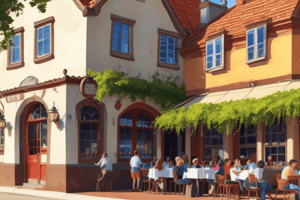Podcast
Questions and Answers
Which of the following best describes the European Union's definition of wine?
Which of the following best describes the European Union's definition of wine?
- A beverage containing a minimum of 9% alcohol by volume derived from grain.
- A product made from any fruit that undergoes alcoholic fermentation.
- A product obtained exclusively from the total or partial alcoholic fermentation of fresh grapes or grape must. (correct)
- Any fermented beverage that is aged for a minimum of one year.
Monks in the Middle Ages contributed significantly to wine production by:
Monks in the Middle Ages contributed significantly to wine production by:
- Developing new grape varieties resistant to common diseases.
- Understanding the importance of hillside slopes for vineyards and selecting appropriate vine stock for ground conditions. (correct)
- Standardizing wine production across Europe through strict regulations.
- Inventing the process of pasteurization to prevent wine spoilage.
What marked a significant challenge to wine's dominance in the beverage market starting in the 17th century?
What marked a significant challenge to wine's dominance in the beverage market starting in the 17th century?
- The introduction of new taxes on wine production and sales.
- The decline in grape quality due to climate change.
- The rise in popularity of beverages like chocolate, coffee, and tea. (correct)
- A series of wars that disrupted wine trade routes in Europe.
Louis Pasteur's invention in 1863, which significantly impacted the wine industry, was:
Louis Pasteur's invention in 1863, which significantly impacted the wine industry, was:
Vitis Vinifera is significant in wine production because:
Vitis Vinifera is significant in wine production because:
What does the term "vinification" refer to in the context of wine production?
What does the term "vinification" refer to in the context of wine production?
In wine production, what does 'viticulture' primarily concern?
In wine production, what does 'viticulture' primarily concern?
What is the correct sequence of the following processes in wine production?
What is the correct sequence of the following processes in wine production?
A wine described as a 'dry wine' is primarily classified by its:
A wine described as a 'dry wine' is primarily classified by its:
Which of the following is a classification of wine based on its 'content'?
Which of the following is a classification of wine based on its 'content'?
Before serving wine, what is a crucial step to ensure proper service?
Before serving wine, what is a crucial step to ensure proper service?
What is the recommended temperature range for serving most white and rosé wines?
What is the recommended temperature range for serving most white and rosé wines?
What is the primary reason for storing wine bottles in a horizontal or upside-down position?
What is the primary reason for storing wine bottles in a horizontal or upside-down position?
When pouring wine for guests, what is the recommended practice regarding the order of service?
When pouring wine for guests, what is the recommended practice regarding the order of service?
What is the purpose of swirling wine in a glass during tasting?
What is the purpose of swirling wine in a glass during tasting?
In the context of wine tasting, what is the significance of noting the 'legs' or 'sheets' on the glass?
In the context of wine tasting, what is the significance of noting the 'legs' or 'sheets' on the glass?
During wine tasting, what is the primary purpose of the first sip?
During wine tasting, what is the primary purpose of the first sip?
In wine tasting, what does 'balance' refer to?
In wine tasting, what does 'balance' refer to?
What is the key characteristic of a congruent wine and food pairing?
What is the key characteristic of a congruent wine and food pairing?
How do complementary wine and food pairings enhance the dining experience?
How do complementary wine and food pairings enhance the dining experience?
Flashcards
Origin of the word 'Wine'?
Origin of the word 'Wine'?
Wine takes its name from the old English word 'win,' pronounced 'wean,' derived from the Latin word 'vinum'.
EU Definition of Wine
EU Definition of Wine
The European Union defines wine as a product obtained exclusively from the total or partial alcoholic fermentation of fresh grapes, whether or not crushed, or of grape must.
Ancient Wine History
Ancient Wine History
Earliest evidence: Wine stain on a Persian amphora (3500 BC, Iran). Mediterranean mention: 1500 BC by Greeks/Phoenicians. Romans spread it in Europe.
Wine in the Middle Ages
Wine in the Middle Ages
Signup and view all the flashcards
17th Century Wine
17th Century Wine
Signup and view all the flashcards
Vitis Vinifera
Vitis Vinifera
Signup and view all the flashcards
Vinification
Vinification
Signup and view all the flashcards
Viticulture
Viticulture
Signup and view all the flashcards
Enology
Enology
Signup and view all the flashcards
Wine Classification by Color
Wine Classification by Color
Signup and view all the flashcards
Wine Classification by Taste
Wine Classification by Taste
Signup and view all the flashcards
Wine Classification by Content
Wine Classification by Content
Signup and view all the flashcards
Serving Wine: Key Steps
Serving Wine: Key Steps
Signup and view all the flashcards
Preparing Wine Glasses
Preparing Wine Glasses
Signup and view all the flashcards
Serving Temperature
Serving Temperature
Signup and view all the flashcards
Opening a Wine Bottle
Opening a Wine Bottle
Signup and view all the flashcards
Pouring Etiquette
Pouring Etiquette
Signup and view all the flashcards
Parts of a Wine Glass
Parts of a Wine Glass
Signup and view all the flashcards
Wine Service Accessories
Wine Service Accessories
Signup and view all the flashcards
Wine Tasting: The 5 S’s
Wine Tasting: The 5 S’s
Signup and view all the flashcards
Study Notes
- Wine is the focus
- The course is Bar and Beverage Management with Lab
Learning Objectives
- To categorize and classify wines
- Identify the senses used in tasting and evaluating wines
- Know the wine service process
What is Wine?
- Name derived from the old English word "win" (pronounced "wean"), based on the Latin "vinum"
- EU Definition: product obtained exclusively from total or partial alcoholic fermentation of fresh grapes (crushed or uncrushed) or grape must.
History of Wine
- Earliest evidence: wine stain on a Persian amphora in Iran (circa 3500 BC).
- Mediterranean mention: circa 1500 BC by Greeks and Phoenicians
- Romans domesticated wine and expanded its production in Europe.
- Romans layed the foundations for modern French vineyards from the 5th century onward
- Middle Ages: Church monks preserved winemaking, developed hillside vineyards, and selected vine stock
- Benedictine Monk Dom Perignon (blind oenologist) perfected Champagne at Haut Villiers Abbey
- Aristocracy supported vine cultivation for economic stability during this period
- 17th century onward: wine faced competition from chocolate (Central America), coffee (Arabia), and tea (China)
- Quest for quality and innovation began in the early 20th century.
- Wine production grew from technological and scientific advancements
- Louis Pasteur invented Pasteurization in 1863
Wine Terminology
- Grape (Vitis Vinifera): vine species that produces 3,000 noble grape varieties
- V.V. is the only vine variety allowed for wines sold in the E.U.
- VV includes major red and white varieties
- Vinification: red and white grapes are used to produce wines
- Viticulture: winemaking practices (crops less than 8 years old are typically of lesser quality)
- Enology: the science of wine production
Wine Production Steps
- Destemming
- Extraction
- Racking
- Fermentation
- Fining
- Blending
- Filtration
- Bottling
Wine Classification
- By Color: White, Red, Rose, Blush
- By Taste: Dry, Medium, Sweet
- By Content: Still, Sparkling, Fortified, Aromatized, Tonic
Wine Service
- Involves how to serve wine, wine glass selection, service accessories, tasting, and pairing methods
Serving Wine
- Presenting the wine list
- Preparing the wine glasses
- Maintaining proper wine serving temperature
- Correctly opening the wine bottle
- Pouring the wine
Presenting the Wine List
- Hand wine lists to each guest
- Help guests with questions
- Take the order
- Offer wines by the glass and wine bottles
Preparing the Wine Glasses
- Select the appropriate wine glassware
- Inspect the glassware for cleanliness
- Polish the glassware
- Place the glassware on a tray
- Deliver the wine glasses
Temperature of Wine
- Whites and Rose often chilled between 50 and 60 degrees F
- Reds served at room temperature (62 to 68 degrees F)
- Sparkling Wine served chilled to 40 to 50 degrees F
- Store all bottles horizontally or upside-down to prevent oxygen exposure
Opening the Bottle
- Use a foil cutter to remove the foil over the cork
- Use a wine key to remove the cork
Pouring
- Before pouring, note how many guests will be drinking to adjust the pour amount
- An average 750 ml bottle provides five pours.
- Never fill a glass more than halfway
- Wrap the bottle in a clean white napkin or use white waiter's gloves to control temperature for chilled wines.
- Pouring Order: Start with the person to the left of the host, regardless of gender, and move clockwise.
- The guest who ordered is always served last.
- Always pour from the guest's right side.
- Finish each pour with a twisting motion and wipe the lip of the bottle to avoid dripping.
Wine Glass Parts
- Base
- Stem
- Bowl
- Rim
Wine Service Accessories
- Decanter
- Wine vacuum pump
- Preservation opener
- Wine chiller
- Polishing cloth
Wine Tasting: The Five S's
- See: Assess color and clarity by tilting the glass over a white background, noting the color and intensity at the core and rim, and checking opacity
- Swirl: Place glass on a flat surface and move the glass in circular motion, this releases aromas and reveals sheets or legs of glycerol
- Sniff: Hold glass in the middle of your chest for very aromatic wines, at your chin for moderately aromatic wines, put nose inside of glass for neutral wines. Take note of fruits, citrus, or stone fruits
- Sip: cleanse the palate and note the reaction of the wine on the tongue
- Savor: Determine the quality of the wine, the relationship between fruit, acid, residual sugar, alcohol, and tannin (velvety/drying sensation), length of flavor, and layers of flavor
Wine Pairing Methods
- Congruent Pairings: share numerous compounds or flavors
- Example: sweet wine with a sweet meal, or a red wine with a buttery pasta dish
- Ensure the wine is not overpowered by the tastes of the food
- Complementary Pairings: are based on food and wine combinations that share no flavors, but instead complement each other
- Their flavors remain balanced by their contrasting elements.
Studying That Suits You
Use AI to generate personalized quizzes and flashcards to suit your learning preferences.





